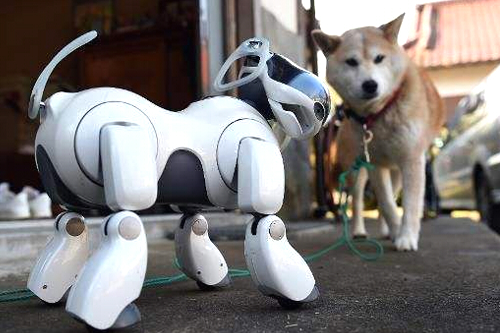Robonurses: Machine Caring
机器人护工:机器关怀
Thousands of Japanese nursing homes are testing robots on residents
成千上万家日本养老院正在试验用机器人提供关怀和护理服务
At Shintomi nursing home in Tokyo, men and women sit in a circle following exercise instructions before singing along to a famous children’s song, “Yuyake Koyake” (“The Glowing Sunset”). They shout out and clap enthusiastically even though the activities are being led, not by a human fitness guru, but by Pepper, a big-eyed humanoid robot made by SoftBank, a telecoms and internet giant.
在东京的新富养老院,老头老太太们按指令围坐一圈,跟着著名儿歌《晚霞渐淡》(Yuyake Koyake)的音乐唱起来。他们热烈地拍手高歌,尽管带领他们的并非人类健康专家,而是由电信及互联网巨头软银(SoftBank)制造的大眼睛人形机器人佩珀(Pepper)。
Japan leads the world in advanced robotics. Many of its firms see great potential in “carerobos” that look after the elderly. Over a quarter of the population is over 65, the highest proportion of any country in the OECD. Care workers are in desperately short supply, and many Japanese have a cultural affinity with robots.
日本的先进机器人技术世界领先。许多日本公司都认为照顾老人的“关怀机器人”(carerobos)具有巨大潜力。日本四分之一以上的人口超过65岁,在经合组织国家中比例最高。护工非常短缺,而许多日本人在文化上也对机器人有亲近感。
For now the market is small. Although the government expects it will more than triple between 2015 and 2020, to ¥54.3bn ($480m), that is a long way below the revenues from industrial and service robots. One big reason for that is expense; few individuals can afford their own robots. Private firms partly rely on government subsidies to develop them; the main customers are nursing homes, which also receive subsidies. Some 5,000 nursing-care institutions are now testing robots.
不过目前这个市场还很小。尽管政府预计2015年到2020年间其规模将会扩张两倍多,达到543亿日元(合4.8亿美元),但仍远低于工业和服务机器人的销售额。其中一大原因是价格——很少有个体能买得起自己的机器人。私营企业部分依靠政府补贴来研发机器人,主要客户是同样享受政府补贴的养老院。现在约有5000家养老护理机构正在测试机器人护工。
Yoshiyuki Sankai, founder of Cyberdyne, a robotics firm that makes some of the most expensive gear, is undeterred. “When Steve Jobs invented the personal computer there wasn’t a market for it,” he says. He has managed to persuade private health-insurance firms such as AIG to help cover the cost of some of his products.
对此,机器人公司Cyberdyne的创始人山海嘉之并不气馁。这家公司生产的一些设备在最贵之列。他说:“乔布斯发明个人电脑的时候,个人电脑市场还不存在呢。”他成功说服了美国国际集团(AIG)等私营医疗保险公司把他的一些产品纳入保障范围。
At Shintomi and elsewhere, much of the equipment helps workers lift, move and monitor residents. A bed from Panasonic, a maker of appliances, splits in two, with one half turning into a wheelchair. Cyberdyne’s lumbar-support suit responds to bioelectric signals from the wearer’s body and helps care-home staff as they bend and lift. Sensors above beds alert workers when a patient moves near the edge and is in danger of falling out. At some homes, excretion sensors on the body monitor intestinal movements to predict when someone needs the lavatory.
在新富养老院和其他地方,很多机器人帮助护工搬移老人,监控他们的状况。家用电器制造商松下公司的机器轮椅床可拆分成两半,一半可以折成轮椅。Cyberdyne的腰部支撑服可对穿戴者身体的生物电信号做出反应,在护工弯腰搬抬重物时提供助力。当病人靠近床边、有跌落的危险时,病床上方的传感器会向工作人员发出警报。在一些养老院,老人身上的排泄传感器会监测其肠道运动的情况,预测何时需要提供洁具。
Robots that communicate and provide companionship are among the most popular at the Shintomi home. Paro, a baby harp seal made by Intelligent System, a Japanese manufacturer, responds to touch and sound, turning to and nuzzling patients who stroke or talk to it. Sony’s Aibo, a robo-dog originally invented as a gizmo for those who had it all during Japan’s bubble years, has become another pet for the old.
在新富养老院,具备沟通和陪伴功能的机器人非常受欢迎。日本制造商Intelligent System制造的海豹宝宝形象的机器人帕罗(Paro)会对触摸和声音做出回应,会转向抚摸它或对它说话的人并亲昵地贴蹭过去。索尼公司的机器狗爱宝(Aibo)最初是为经济泡沫时期生活富足的日本人发明的一个小玩意儿,现在已成为老年人的又一新宠。

Multi-purpose robots such as Pepper seem especially promising. In other businesses, Pepper specialises in customer service. But in nursing homes it talks to patients and monitors corridors at night (as well as running exercise classes).
看起来,像佩珀这样的多功能机器人市场前景尤佳。在其他行业,佩珀专事客户服务,但是在养老院里,除了组织锻炼之外,它还会和老人说话、在晚上监控走廊。
Robot technology has much further to go if the machines are to replace human carers. “That will not happen until they have sontaku,” says Yukari Sekiguchi, Shintomi’s manager, referring to the Japanese concept of understanding by implication. “It cannot tell from a glance that someone fancies a cup of tea. I can.” Human social interaction is still much easier to solve using robots than manual tasks are, says Kenichi Yoshida, who runs SoftBank’s robotics division. For now, only humans can do tasks such as brushing a patient’s teeth or shaving them.
要取代人类护工,机器人技术还有很长的路要走。新富养老院的经理关口由加里说:“要等到机器人有了‘sontaku’的能力才可能替代人。”Sontaku在日语中是揣摩、推测的意思。“机器人不能从你的一个眼神里看出来你想喝茶。我能。”不过,软银机器人部门的主管吉田健一表示,用机器人解决人类社交互动的问题还是要比用它们完成人工作业容易得多。目前,只有人可以完成帮病人刷牙或剃须等任务。
Even so, many residents at Shintomi are keener on the robots than they are on some of the care workers, notes Mr Sekiguchi. A recent nationwide study found that using robots encouraged over a third of residents to become more active and autonomous. The earliest adopters of robotics may well be people in the later stages of life.
尽管如此,关口指出,相较于人类护工,新富养老院的许多老人更喜欢机器人。最近日本一项全国性研究发现,使用机器人让养老院里超过三分之一的老人变得更加积极自主。最早接受机器人的人很可能恰恰是处于人生暮年的老人。
下载:英文、中文版本








